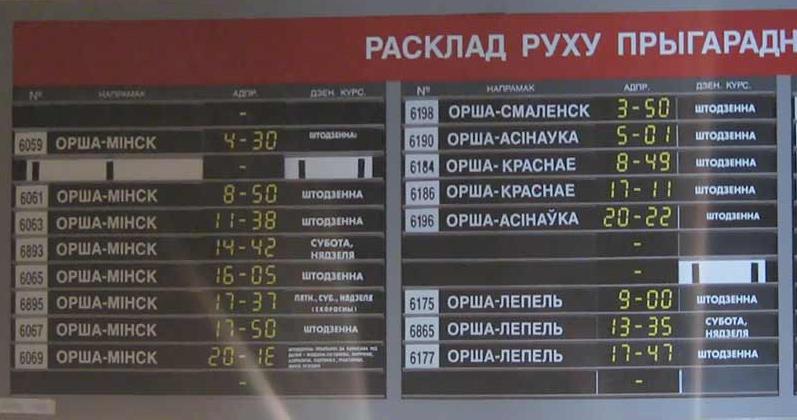train schedule. Railway

Hi,% Username%!
I see you liked my last topic with the railroad, well, let's try to understand another interesting point.
We continue to share knowledge . Today let's talk about the train schedule
upd: link to wiki by niro
In the comments to past topics, I noticed an interest in the train schedule.
As always on the fingers ...
You already know that on the railway there is not only a “passenger”, but also freight trains, and take off and economic (for domestic needs), rehabilitation, and, do not believe, even firefighters, and so on. Since there are many trains and little, you need to regulate their movement.
Looking ahead, I will say that recently Minsk created the MCC - Center for
')
So there are a lot of trains, and to regulate their movement on the territory of the Republic of Belarus, a so-called train schedule is created. This is a very important document, which states how, at what speed, where, in what sequence, for what, with how often the trains move. Also there are scheduled repairs and so on.
The Train Movement Schedule (hereinafter referred to as the MPD) is such a sheet of format slightly larger than A1, which graphically displays all the information I have just mentioned.
And now the pictures (I apologize right away, I am writing from the parent company, there is nothing but the peint).
Here is a simplified flow chart diagram.

For a sense of horror, multiply the density of the lines and the size by 10, you get a paper with a bunch of incomprehensible, not leading lines))))) (remembered your diploma)))
So on schedule:
horizontally we have the time scale for vertical distance.
We see that we have several stations: A, B, C, G. The station B is the largest, for example, a sorting station. You also noticed periodic and aperiodic lines of 3 colors: red-passenger trains, black-freight, blue - suburban (diesel and electric).
Creating a DDP
Let's now understand what is what:
Passenger train number 2 went from station G, after a while he arrived at station B, after standing there for a couple of minutes, went and, after some time, arrived at the destination station - station A. Well, everything seems to be clear ...
Now freight train number 2142:
As we see, he went some time after passenger number 2, but at station B, the difference in time is already more noticeable, even more, by the time 2142 arrived at station B, passenger number 2 was already at station A. From here we we see that the slope of the lines indicates speed. The steeper - the higher the speed. Cargo No. 2142 arrived at station B, and was technologically processed for some time, then it returns to station G, but, attention !, as I said in past posts, it returns, but already changing the number from even to odd On our schedule it changes 3 times your number, maybe more, and maybe less.
A commuter train runs between station A and B, as we see, all trains must be tied up. Look, he is fixated, which gives a reduction in rolling stock units.
Suburban trains are applied last. They develop the schedule as follows: commuter trains must bring people in before robots, take them away, run during rush hours and during hours of mass insanity (such as weekends to the cottage).
funny moment about commuter trains. By the type of cruising, they can be either “slow moving” or, attention, “fast-moving”. Do not be deceived by the fact that your diesel runner does not speak about its advantages in speed, this is just a term saying that a diesel (train) will not stop at every stopping point. Transcendental speeds you will not see!
Now the moment that I am sure was with you all.
Look at passenger number 4, arriving at station B, it is worth a few minutes to skip passenger number 3. Since, for example, train number 3 is fast, and number 4 is just passenger.
Compare No. 2 and No. 4 - they are both passenger, and they have the same technical capabilities, but due to the fact that it had to stop at station B, its speed limit was much lower than that of the 2nd. This is clearly visible at station B - a temporary discrepancy in which is almost 2 times greater than the departure from station G.
This is how it is. Makes the GDP engineer graphist in the department. OWG is compiled into plots. For example, especially strictly, the Brest - Moscow section. The schedule can be completely on the site, but only some stations will appear there, and it can also be broken down into smaller ones, for example, Minsk-Orsha, etc.
Another interesting fact:
trains can go one after the other in one direction in no less than 8 minutes, provided that there is an automatic blockage.
ps
Schedule to horror simplified.
The very theme of the schedule of train movement is very complex, full of nuances and all sorts of nastiness.
At the university, we were being able to pair it over the course of all 5 years, so that it is not enough to fit 10 lines.
From today's post you, most importantly, have to catch that the schedule is not just created. The departure times of trains are not set by balds. The fact that it is very difficult and responsible. After all, on the railway there is such an indicator as a simple freight car. Extra simple is the loss of money. Therefore, the cost of time railway workers know. Colleagues will support me.
Thanks for attention. See you soon…
Source: https://habr.com/ru/post/65381/
All Articles